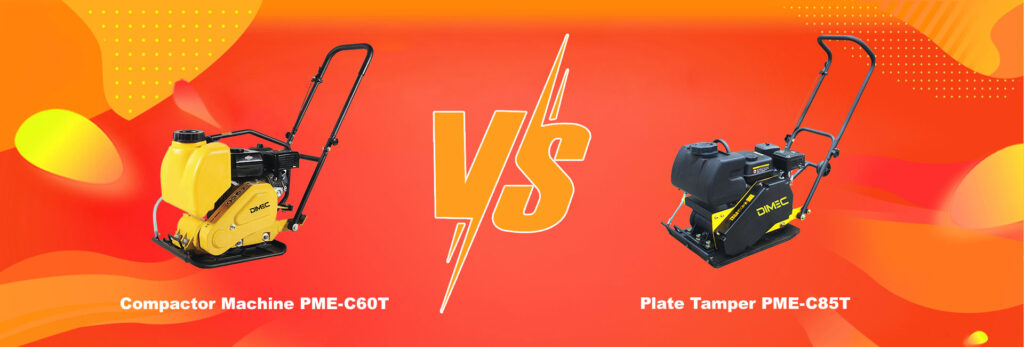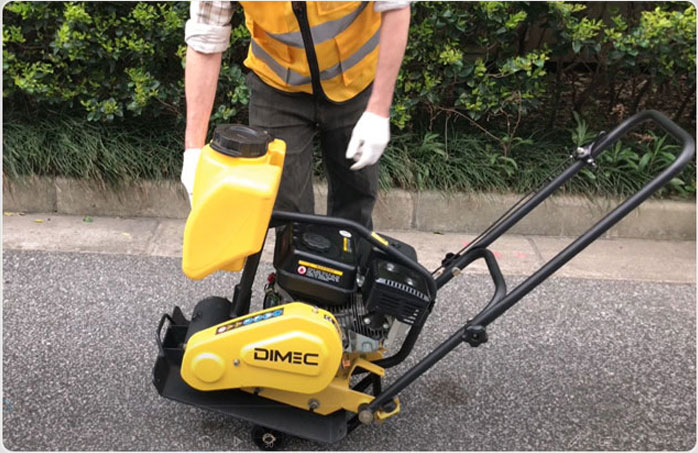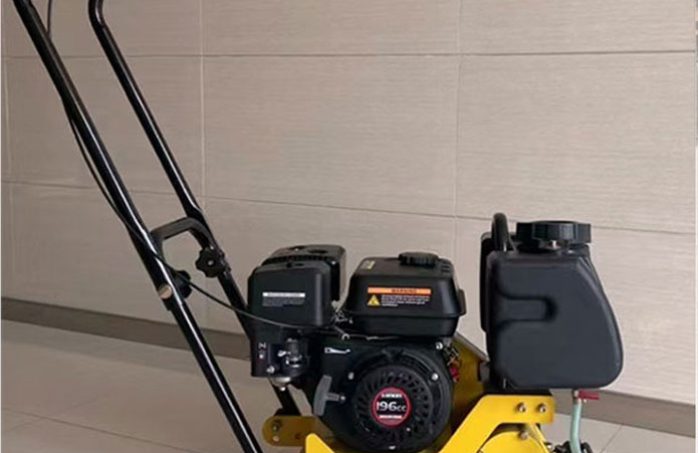Compactor Machine PME-C60T vs Plate Tamper PME-C85T: A Detailed Comparison
- DIMEC
- Compactor Machine, Plate Tamper
- 20/02/2025
Home » Compactor Machine PME-C60T vs Plate Tamper PME-C85T: A Detailed Comparison

Table of Contents
Introduction
In the construction industry, selecting the right compaction equipment is crucial for ensuring efficient and effective soil compaction. The Compactor Machine PME-C60T and Plate Tamper PME-C85T are two popular models that cater to different project requirements. This article provides a comprehensive comparison of these two machines, focusing on their technical specifications, performance capabilities, and ideal applications.
Technical Specification
| Model | Compactor Machine PME-C60T |
|---|---|
| Engine | Honda / Robin / Loncin / Diesel engine |
| Engine type | Air-cooled, single cylinder, 4-stroke, petrol engine / diesel engine |
| Frequency [VPM] | 5600 |
| Centrifugal force [KN] | 12 |
| Plate size (LxW) [cm] | 50x36 |
| Max.compaction depth[cm] | 28 |
| Travel speed [m/min] | 25 |
| Max.inclination angle | 20° |
| N.W./G.W. [kg] | 68/73 |
| Package (LxWxH) [cm] | 75x38x61 |
| Model | Plate Tamper PME-C85T |
|---|---|
| Engine | Honda / Robin / Loncin / Diesel engine |
| Engine type | Air-cooled, single cylinder, 4-stroke, petrol engine / diesel engine |
| Frequency [VPM] | 4200 |
| Centrifugal force [KN] | 14 |
| Plate size (LxW) [cm] | 59x43 |
| Max.compaction depth[cm] | 30 |
| Travel speed [m/min] | 25 |
| Max.inclination angle | 20° |
| N.W./G.W. [kg] | 86/91 |
| Package (LxWxH) [cm] | 75x45x58 |
Performance Comparison
Engine Power and Efficiency
Both machines are powered by a 5.5 HP engine, providing sufficient power for demanding compaction tasks. However, the PME-C85T’s larger plate size and higher compaction force make it more suitable for large-scale projects.
Plate Size and Compaction Force
The PME-C60T has a 50 x 36 cm plate, generating a compaction force of 12 KN/sq.ft, while the PME-C85T features a larger 64 x 42 cm plate, delivering a more significant compaction force of 15 KN/sq.ft. This makes the PME-C85T ideal for projects requiring deep and uniform compaction.
Operational Speed and Coverage
The PME-C60T operates at a higher vibration frequency of 5600 VPM, allowing for faster compaction over smaller areas. In contrast, the PME-C85T, with a vibration frequency of 4200 VPM, covers larger areas more efficiently due to its larger plate size.
Applications and Ideal Projects
Compactor Machine PME-C60T
- Urban Road Repairs: Excellent for dust control and avoiding work stoppages near sensitive zones.
- Desert Solar Farms: The water tank enables compaction of dry sand without external water trucks.
- Mining Access Roads: Controls silica dust and navigates temporary haul roads effectively.
Plate Tamper PME-C85T
- Large-Scale Road Construction: Ideal for achieving deep compaction depths required for highway subgrades.
- Industrial Foundations: Suitable for heavy-duty compaction tasks in industrial settings.
- Commercial Paving: Provides high compaction force and speed, making it perfect for extensive paving projects.
Operational Considerations
Ease of Use and Ergonomics
Both machines incorporate advanced low-vibration technology and ergonomic controls to ensure operator comfort during prolonged use. The PME-C60T’s compact design makes it easier to maneuver in tight spaces, while the PME-C85T’s larger size is better suited for open areas.
Maintenance and Durability
Regular maintenance is essential for both machines to ensure peak performance. The PME-C60T has a relatively simple design, making maintenance tasks straightforward. The PME-C85T, with its more complex components, requires more frequent checks but is built to endure heavy-duty use.
Cost-Effectiveness and ROI
The PME-C60T offers excellent value for small to medium-sized projects, providing reliable performance without excessive power costs. The PME-C85T, although more expensive initially, offers significant long-term savings by reducing labor costs and project timelines in large-scale projects.
Conclusion
Choosing between the Compactor Machine PME-C60T and Plate Tamper PME-C85T depends on your project’s specific requirements. If you need a machine for dust control, urban projects, or small-scale tasks, the PME-C60T is the better choice. For large-scale, heavy-duty projects requiring deep compaction, the PME-C85T is the clear winner.
By understanding the differences in engine performance, plate size, operational speed, and application suitability, you can confidently select the machine that will ensure the success of your construction project.
FAQs
Q1: What is the main difference between the PME-C60T and the PME-C85T?
The main difference lies in their plate size and compaction force. The PME-C60T has a smaller plate and lower compaction force, making it suitable for smaller projects, while the PME-C85T has a larger plate and higher compaction force, ideal for large-scale projects.
Q2: Which machine is better for confined spaces?
The PME-C60T is better suited for confined spaces due to its smaller size and lighter weight, making it easier to maneuver in tight areas.
Q3: How do the engine powers compare between these models?
Both machines are powered by a 5.5 HP engine, but the PME-C85T’s larger plate size and higher compaction force make it more suitable for demanding tasks.
Q4: What types of projects benefit most from the PME-C85T?
Large-scale road construction, commercial paving, and high-traffic area development projects benefit most from the PME-C85T due to its deep compaction capabilities and high compaction force.
Q5: How do both machines ensure operator comfort during prolonged use?
Both machines incorporate advanced low-vibration technology and ergonomic controls to minimize operator fatigue and ensure comfort during extended use.
Feel free to contact us for any questions and doubts.
Plate Compactor X Tamping Rammer X Road Roller
Feel free to contact us for any questions and doubts
You May Also Like
10 Common Mistakes When Using a Concrete Mixer
Table of Contents Introduction: Understanding the Common Mistakes in Concrete Mixing When it comes to using a concrete mixer, mistakes can have serious implications on the outcome of your project. Whether you’re working on a large-scale construction site or a small DIY project, knowing what pitfalls to avoid can help you achieve a durable and high-quality concrete mix. This article will guide you through the 10 most common mistakes made when using a concrete mixer and how to prevent them. By understanding these errors, you can save time, money, and effort while ensuring that your concrete is mixed perfectly every time. 1. Not Properly Setting Up the Concrete Mixer One of the first mistakes many people make is not properly ...
Read More →
How to Identify a Reliable China OEM Plate Compactor Supplier?
Table of Contents Introduction Choosing a reliable supplier for OEM plate compactors is crucial for ensuring product quality and maintaining smooth operations. OEM (Original Equipment Manufacturer) plate compactors are essential in various industries, from construction to landscaping, due to their efficiency in compacting soil, gravel, and asphalt. In this guide, we’ll explore the key factors to consider when identifying a reliable China OEM plate compactor supplier. Understanding OEM Plate Compactors What are Plate Compactors? Plate compactors are machines used to compress and stabilize soil, gravel, and asphalt, creating a solid and even surface. They are commonly used in construction and landscaping projects to prepare foundations, driveways, and pathways. Benefits of Using OEM Plate Compactor Products OEM products are manufactured by the ...
Read More →
The Ultimate Earth Rammer Buying Guide
Table of Contents Are you planning a construction project, landscaping endeavor, or any other task that requires compacting soil or loose materials? If so, investing in a high-quality earth rammer could be the game-changer you need. These powerful machines are designed to densify and compact soil, gravel, and other materials, creating a sturdy foundation for your project. However, with the vast array of options available, choosing the right earth rammer can be a daunting task. In this comprehensive guide, we’ll walk you through everything you need to know to make an informed purchase decision. Introduction to Earth Rammers What is an Earth Rammer? An earth rammer, also known as a soil compactor or a tamping rammer, is a versatile tool ...
Read More →
The Ultimate Guide to Concrete Floor Saws
Table of Contents Understanding Concrete Floor Saws Concrete floor saws are indispensable tools in construction and renovation projects, designed to make precise cuts into concrete surfaces. These powerful machines are used for various applications, including roadwork, slab cutting, trenching, and more. With the growing demand for efficient and clean concrete cutting, concrete floor saws have become essential for professionals who need to complete heavy-duty tasks safely and quickly. What is a Concrete Floor Saw? A concrete floor saw is a mechanical tool equipped with a diamond blade that’s specifically designed to cut through concrete, asphalt, and other hard materials. These saws are often used in road construction, building renovations, and even in situations that require creating trenches or slots in ...
Read More →
What Are the Different Types of Concrete Cutters?
Table of Contents In the ever-evolving world of construction and renovation, concrete cutting has emerged as a crucial task. Whether you’re demolishing an old structure, creating openings for new installations, or reshaping concrete surfaces, having the right tools and techniques is paramount. Enter the world of concrete cutters – a versatile array of machines designed to tackle even the toughest concrete jobs with precision and efficiency. This comprehensive guide delves into the different types of concrete cutters available, their unique features, and their suitability for various applications. We’ll explore hand-held models, walk-behind cutters, ride-on machines, and even specialty cutters for intricate tasks. By understanding the strengths and limitations of each type, you’ll be better equipped to choose the perfect cutter ...
Read More →
The Ultimate Checklist for Buying a Vibrator Frog Compactor Rammer
Table of Contents When it comes to construction and landscaping projects, having the right equipment is crucial for efficiency and quality. One such essential piece of machinery is the vibrator frog compactor rammer. This tool is invaluable for compacting soil, gravel, and asphalt, ensuring a solid foundation for any project. However, with numerous options available in the market, choosing the right one can be daunting. Here’s the ultimate checklist to help you make an informed decision when buying a vibrator frog compactor rammer. Understanding the Basics What is a Vibrator Frog Compactor Rammer? A vibrator frog compactor rammer, commonly known as a soil compactor or tamping rammer, is a machine used to compact soil and other materials. It utilizes a powerful engine to ...
Read More →
Preferred Brands of Engineering Compaction Equipment
Three Core Product Lines for Efficient Construction

Plate Compactors (40KG - 750KG)
We offer a wide range of models from light to heavy - duty. Modular design fits multiple jobs like municipal work and asphalt repair.

Tamping Rammers (32KG - 90KG)
Nine models with Honda/Robin/Loncin power. Smart fuel control and ergonomic design. Ideal for trench and slope work.

Road Rollers (0.3T - 5.5T)
Multi - level amplitude for different materials, and real - time compaction monitoring. Serve all road - building stages.

